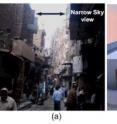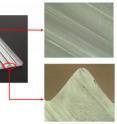Let the sun shine in: Redirecting sunlight to urban alleyways
Related images
(click to enlarge)
In dense, urban centers around the world, many people live and work in dim and narrow streets surrounded by tall buildings that block sunlight. And as the global population continues to rise and buildings are jammed closer together, the darkness will only spread. To alleviate the problem, Egyptian researchers have developed a corrugated, translucent panel that redirects sunlight onto narrow streets and alleyways. The panel is mounted on rooftops and hung over the edge at an angle, where it spreads sunlight onto the street below. The researchers describe their design in a paper published today in Energy Express, a supplement of The Optical Society's (OSA) open-access journal Optics Express.
"We expect the device to provide illumination to perform everyday tasks, and improve the quality of light and health conditions in dark areas," said Amr Safwat, a professor of electronics and communications engineering at Ain Shams University in Cairo, Egypt. These dimly lit areas specifically include narrow streets in developing countries, but Safwat said the new panel could be used in any country as a greener, cheaper, and more pleasant alternative to fluorescent and other artificial light.
While other commercially available window-like devices can redirect light, they are designed for shade and redirecting glare or for brightening a room -- not a narrow street. So the researchers decided to create their own design. They wanted a simple way to redistribute natural light without the need for a tracking device that follows the rising and setting sun.
What they came up with is a panel made of polymethyl methacrylate (PMMA), the same acrylic plastic of which Plexiglas is made. The bottom of the panel is smooth while the top is covered in ridges that are based on a sine wave, the mathematical function that describes everything from light to pendulums. The researchers used computer simulations to find the size and shape of the grooves that distribute the most amount of sunlight in a wide range of sun positions all year round, whether it's high or low in the sky. A sine-wave pattern is also easy to manufacture.
Using simulations of sunlight shining on an alleyway, the researchers found that their panels increased illumination by 200 percent and 400 percent in autumn and winter, respectively, when sunlight is most limited. They also tested a small prototype over a 0.4-meter-by-0.4-meter shaft that is 1.2-meters deep and found that it lit up the area as designed.
The next step, Safwat said, will be to build a full-scale model 10 times bigger to validate their calculations and to test it in a real alleyway. The team then plans to market and commercialize the panel. He estimates that a one-square-meter panel and a frame will cost between $70 and $100.
And that may be a small price to pay for the benefits of sunlight. The lack of sun in urban areas doesn't just make life gloomy; it can be harmful to your health, Safwat said.
"Research has shown that lack of natural lighting can cause severe physiological problems," such as serious mood changes, excessive sleeping, loss of energy and depression, Safwat said.
He also noted that using sunlight to illuminate historical places -- such as ancient alleyways in Egypt -- also helps preserve the authenticity of the site, maintaining its cultural value and historical significance.
This work was funded by the Science and Technology Development Fund of Egypt.
Source: The Optical Society
Other sources
- Let the sun shine in: Redirecting sunlight to dark urban alleywaysfrom Science DailyTue, 15 Apr 2014, 7:16:12 UTC
- Let the sun shine in: Redirecting sunlight to urban alleywaysfrom PhysorgMon, 14 Apr 2014, 15:51:08 UTC


